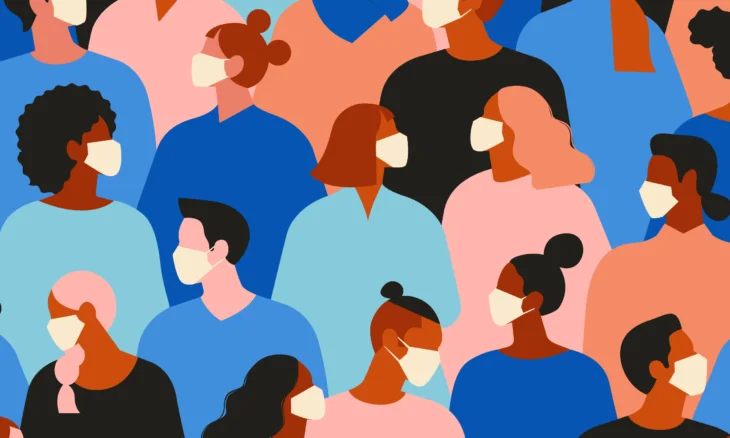In the two years since the start of the COVID-19 pandemic, public health has been increasingly recognized as a social justice issue: from racial disparities in hospitalizations and deaths from COVID-19 to the increased risks for unhoused people during the pandemic, different communities have experienced the pandemic in profoundly different ways. Both globally and within the US.
With significant work by racial and social justice advocates, the toll of the pandemic has become part of a call to address the ways that the structural problems in society we know so well—wealth inequality, broken education systems, gender and racial discrimination and more—lead to large disparities in public health. These diverse aspects of identity, culture and place are referred to as “upstream factors” or “social determinants” in public health and can play out across systems like health insurance or through behavioral factors like drug addiction—themselves often tied to a range of social factors. Many of these determinants come from institutional policies and structures, including racially segregated housing and education systems, taxation policies, urban planning and immigration laws. From social and institutional inequalities to living conditions, these play a major role in the inequalities seen in public health: disparities in life expectancy, chronic illnesses, communicable diseases and infant mortality.
“The further we progress in this pandemic the more we feel that the inequities being exacerbated are only going to worsen,” Rosemary Morgan of Johns Hopkins Bloomberg School of Public Health told The Guardian in a recent interview on COVID-19 and gender inequality.
But organizations and advocates pushing for health equity are clear: upstream factors don’t determine the course of people’s lives, and a growing surge in proactive solutions can make a difference. Community-driven programs, advocacy and education can help dismantle the link between social inequities and negative health impacts. With the right support, a new community group can tackle substance abuse. Local community leaders can put together a campaign to address poor nutrition and food access issues through culturally grounded education and material support.
The pandemic has brought a surge in new research into social determinants of health, with public health researchers calling for governments to act to remedy the “resource limitations and barriers to access [that] prevent meaningful intervention and health promotion.” As early as mid-2020, research published in The Lancet medical journal argued that “regular income support to low-income households, access to testing and shelter among the homeless, and improving health-care access in low-income neighborhoods have the potential to dramatically reduce future pandemic morbidity and mortality.”
The social factors influencing health include everything from the social and environmental conditions of a neighborhood to income and educational opportunities. Researchers from the University of California and Harvard have shown that education is linked to physical health outcomes through literacy, employment and psycho-social health. Similarly, working conditions can influence an individual’s health prospects via physical hazards, social environment and economic stability. One 2018 study led by researchers at the University of California, Berkeley found that the largest disparities in public health come at the intersection of multiple factors and identities. People from historically marginalized racial or ethnic groups who also faced socioeconomic inequity were most likely to experience disproportionately negative health outcomes. Notably, these disparities also persisted across socioeconomic status, meaning that factors like structural racism continued to play a role in people’s health outcomes regardless of class. Researchers at Harvard’s School of Public Health have highlighted that discrimination itself can be viewed as a social determinant of health in the US context: whether at the institutional or individual level, discrimination along racial, gender or other lines impacts health through three major pathways: psychosocial stress, access to health and social resources and bodily harm or violence.
Calls to address these upstream factors in public health aren’t new. In 1978, the globally-recognized International Conference on Primary Health Care made a commitment known as the Alma-Ata Declaration that called on the United Nations and governments around the world to adopt a more holistic vision of “health for all”. The World Health Organization continues to endorse this framework today: in 2008, the international Commission on Social Determinants of Health emphasized as one of its three “principles of action” the fundamental need to “tackle the inequitable distribution of power, money, and resources – the structural drivers of those conditions of daily life – globally, nationally, and locally.”
Addressing the social determinants of public health is a central strategy in the fight for health equity and to eliminate health disparities. It’s this focus on social factors—race, class, gender, wealth and more—that shows health equity is necessarily a social justice issue and makes it crucial to combine approaches from physical health, mental health, education and advocacy.
These factors are also highly personal and contextual: the ways that race and class play manifest and play out in the realm of public health vary dramatically based on communities and place. As far back as the Alma-Ata declaration, public health experts affirmed that people have a right to participate in “planning, organization, operation and control” of their health care. This means that efforts to craft solutions must always be bottom-up and community-driven: the people who call a place home have the expertise and wisdom to know what can work for them in their context. Though larger organizations and governments can provide much-needed support, it’s local residents, advocates and leaders who need to decide where to invest resources and where to build interventions that can improve the lives of their communities. From their perspective, social determinants of health likely aren’t new concerns: they’re the same struggles for equity and social justice that local advocates have worked on for years, and any effective public health solutions will depend on tapping into this expertise.










